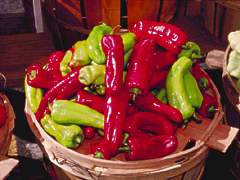|
Brandt, Linda. Gardening in Containers. Menlo Park: Lane
Publishing Co., 1977.
|
|
Careaga M, et al. Antibacterial activity of Capsicum extract against
Salmonella typhirium and Pseudomonas aeruginosa innocuatedin raw beef
meat. Int J Food Microbiol 83(3):331-5, 2003.
|
|
Cross Country Nurseries. Photos of Chile Peppers (used in Common
Culinary Peppers page). URL:
http://www.chileplants.com/
|
|
De Lucca AJ, et al. CAY-1, a fungicide saponin from Capsicum sp. fruit.
Med Mycol 40(2), 2002.
|
|
El Hamms R, et al. Antimutagenic properties of bell and black peppers.
Food Chem Toxicol 41(1):41-7, 2003.
|
|
Kilham, Chris. Psyche Delicacies: coffee, chocolate, chiles, kava,
and cannabis, and why they're good for you. USA: Rodale, 2001.
|
|
Leuschner RG, Ielsch V. Antimicrobial efects of garlic, clove and red hot
chilli on Listeria monocytogenes in broth model systems and soft cheese.
Int J Food Sci Nutr 54(2):127-33, 2003.
|
|
Macho A, et al. Non-pungent capsaicinoids from sweet pepper synthesis and
evaluation of the chemopreventative and anticancer potential. Eur J Nutr
42(1):2-9, 2003.
|
|
Miller, Mark. The Great Chile Book. Berkeley: Ten Speed Press,
1991.
|
|
Morre DJ, Morre DM: Synergistic Capsicum-tea mixtures with anti-cancer
activity. J Pharmacol 55(7):987-94, 2003.
|
|
Naj, Amal. Peppers: A Story of Hot Pursuits. New York: Alfred
A. Knopf, Inc., 1992.
|
|
Renault S, et al. CAY-1, a novel antifungal compound from cayenne pepper.
Med Mycol 41(1):75-81, 2003.
|
|
Rodale, Robert (ed). The Basic Book of Organic Gardening. New
York: Ballantine Books, 1971.
|
|
Rotblatt, Michael and Irwin Ziment. Evidence-Based Herbal Medicine.
Philadelphia: Hanley & Belfus, Inc., 2002.
|
|
Surh YJ. Anti-tumor promoting potential of selected spice ingredients with
antioxidative and anti-inflammatory acivities: a short review. Food Chem
Toxicol 40(8):1091-7, 2002. |
|
Wright, Michael. The Complete Indoor Gardener. New York: Random
House, 1974.
|
|
Zhang J, et al. Capsaicin inhibits growth of adult T-cell leukemia cells.
Leuk Res 27(3):275-83, 2003.
|



